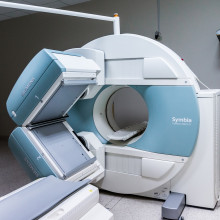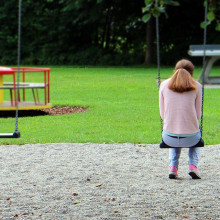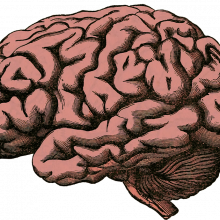This time on Naked Neuroscience, James Tytko explores the miracle of magnetic resonance imaging (MRI) with Stephanie Brown from the University of Cambridge, including a new innovation to decrease 'scan-xiety' amongst children. Then, we'll be investigating the complexities of the current youth mental health crisis, with the help of Susanne Schweizer and Camilla Nord...
In this episode

00:51 - Alleviating MRI anxieties
Alleviating MRI anxieties
Stephanie Brown, University of Cambridge
James Tytko spoke with the University of Cambridge's Stephanie Brown to learn about magnetic resonance imaging (MRI) and how professionals are helping children deal with the anxiety of a scan...
Stephanie - MRI stands for Magnetic Resonance Imaging and an MRI scanner contains a strong magnet, basically. MRI scanners come in different strengths of magnet and stronger magnets give us higher resolution in the images. So the way this works technically is that protons within bodily water molecules act like very small magnets, which we can manipulate with the strong magnet inside the scanner and radio waves to form images.
James - When it comes to why someone might be asked to have an MRI, specifically of their brain this is, what's going to have caused that?
Stephanie - There's a variety of reasons. It could be for research purposes or it could be because it is suspected by a clinician that there may be something abnormal in the brain. In research, a commonly used technique is functional MRI or fMRI for short. Functional MRI is different to a structural MRI, which is commonly used in the clinic, as it uses blood oxygenation which has different magnetic properties to deoxygenated blood - if we remember, that is, the iron in our blood cells that is important for carrying oxygen. This tells us about the activity in the brain and the idea behind this is that active neurons use more oxygen for energy. So, using this information, we can create maps of the brain for which regions are using higher levels of energy when people are, for instance, resting or doing a very specific task.
James - We know that the brain is very complicated and there's lots about it we still don't know. So what is it that an MRI or an fMRI can actually tell us?
Stephanie - Brain MRIs, both functional and structural, can tell us really quite a lot about healthy psychological processes and also what might be happening when people might be suffering from diseases or disorders. This can include things like memory, language, pain, or the physical processes that happen for instance during Alzheimer's disease or Parkinson's. Technology is always improving. This allows us to get further information about how the brain works in healthy and diseased states. Importantly, these changes that we might be able to detect on an MRI scan can be used for better and more effective diagnoses. Often, having or not having a biologically based diagnosis can really stand in the way of effective treatments.
James - And so far we've focused quite a lot on the technical side of things which is great. But someone who's actually had an MRI scan will be the first to tell you, especially of their brain, it's something of an anxiety inducing experience, isn't it, given the sounds this machinery makes and the way you are sort of engulfed in it?
Stephanie - Yes, so it definitely can be. So, to have an MRI, you would usually be asked to lie down on a table and go into a tube in an MRI scanner, this is where the magnet is located. Then you're just asked to lie very still for the duration of the scan, which can vary according to what doctors or researchers might be interested in looking at. Most people actually don't mind having an MRI scan and some people find it quite comfortable or even fall asleep. However, some people may really struggle to stay still. This is especially true for children who might find the environment a bit claustrophobic or find it too noisy. But we can often find solutions to these problems. Some people may find the scanner less claustrophobic, for instance, if they've seen the scanner before and had some time to mentally prepare. You will also usually wear earplugs to minimise the noise and sometimes there can be a helpful distraction provided such as listening to music or watching something when you're in the scanner, which can be really beneficial for reducing anxiety.
James - Because what we want to avoid as much as possible is putting people under anaesthetic while they're undergoing these scans. Because there's some research that suggests that especially, as you mentioned, for young children, there's developmental concerns of putting them under anaesthetic too frequently.
Stephanie - Yes, that's exactly right. So this brings us onto a very interesting recent article published in the BMJ and what they found in this research was that giving children a virtual augmented reality play kit to use ahead of an MRI really seemed to ease both that and their parents' anxieties about the procedure. So MRI, as we've mentioned, is a really important diagnostic tool in children's healthcare because of the high quality images, but also the lower radiation exposure compared with something like a CT scan, which is particularly important for children with long-term conditions. But many children really do find this a challenging experience. As you mentioned, recent research has really brought up some safety concerns about the potential impact of anaesthesia on a child's developing brain and this has really pushed forward an initiative to reduce the number of MRI scans done under sedation.
James - The BMJ's 'Augmented Reality Innovation.' What's that? What does that even mean?
Stephanie - They've developed a play kit which consists of a flat packed cardboard kit for building into a small toy MRI scanner into which the child can place their toy. A smartphone is slotted into the side of the cardboard MRI scanner, which enables the child to take on essentially the role of a radiographer via an augmented reality app. And augmented reality superposes a computer generated image on a user's view of the real world so the child can then essentially scan their toy with the addition of scanning noises to replicate the MRI experience. The feedback from this study indicated that the play kit really helps some children and their parents and carers to prepare for the MRI scan and helps to relieve anxiety as well. The children themselves said that recalling aspects of the play kit during their scan helped them remain calm and still, which is obviously really beneficial and a positive step.

08:39 - Is uncertainty driving the youth mental health crisis?
Is uncertainty driving the youth mental health crisis?
Susanne Schweizer, University of New South Wales
Susanne Schweizer, incoming associate professor at the University of New South Wales, has been studying the trends in adolescent mental health over the past decade and believes one of the drivers of the downturn is increases in uncertainty. This might account for, as she argues, why we see the problem getting worse during the Covid pandemic - an extremely uncertain time for so many, as she related to James Tytko…
Susanne - Young people coming of age today, they've faced very volatile financial markets, they were all born during or post the global financial crisis, and they have experienced a steadily increased worsening of the global climate. They now don't know about the future liveability of their planet, let alone the liveability of the planet for any offspring that they may have.
James - Haven't we always lived in uncertain times? Could you argue there's been war, there's been economic downturn, there's been political upheaval for time immemorial?
Susanne - Absolutely. And I think that's a really good point. Surely, you'd say, world wars, droughts, famines, these are times of extreme uncertainty. So what's different now? Well, I don't think that they are different. The thing is that we don't know what was happening to youth mental health at the time because we've only been systematically assessing it and tracking it over the last couple of decades. So from the time since we've been tracking youth mental health, it's the first time that we see this statistically significant increase in mental health problems. Definitely in the last decade, but there's some indicators that put it even a bit earlier, sort of 2008/2006 as a starting point at which this really started to significantly increase in this age group.
James - I wonder if we could backtrack slightly and talk about uncertainty from the psychological perspective because, as much as we might say it might be a driving factor towards poor mental health, it's also in us for a reason, right? It's got its uses.
Susanne - Absolutely. As a species we're incredibly averse to uncertainty. We really don't like it. There was this early experiment in the 60's by an economist called Ellsberg. It showed that people will be willing to incur financial cost in order to avoid uncertainties. The avoidance, or trying to eracidate uncertainty, is incredibly important because that gets us to try and predict the weather, gets us to try and predict stock markets, etc. Developmentally, adolescence has always been a time of great uncertainty. It's a time point where you go from your known environment, your family environment to, with increasing independence, your world really drastically changes; your relationships, the amount of relationships you have, the focus away from the immediate family towards peers and dynamically changing relationships. All of these scenarios are inherently novel and therefore also uncertain. We've seen time and again in behavioural research, in neuroscience research, adolescents are much more willing to go and explore their environment. That's, again, arguably developmentally important because to be successfully navigating a new adult environment, you have to go out and explore it!
James - We talk about how resilient children are and that chimes with what you're saying: that uncertainty is a fact of life when you are young and something that can't be avoided and so you have to be able to deal with it.
Susanne - Yes. Beyond that, even within normative levels of uncertainty, why do some young people go on to develop mental health problems but others not? We've looked at the behavioural willingness to approach uncertainty: uncertainty makes you feel more negative than someone else. If you're less able to cope with uncertainty emotionally, then you are more vulnerable towards developing mental health problems. But what we've not done is we haven't actually looked at intolerance of uncertainty across the lifespan. In a recent study where we've actually done this, we see again that young people are those who report the highest levels of intolerance of uncertainty when we directly compare it to adults. So while they may be behaviourally ready and, especially in social contexts, willing to go out and explore, go out and take risks, this may actually come at an effective cost in that they may actually not feel good doing this. This may actually be distressing to them.
James - And I guess that would make sense as to why you become more risk averse as you age because you begin to associate uncertainty with these not nice feelings.
Susanne - That's exactly right. We see an increase in sensation seeking and risk taking over the course of adolescence and it peaks in late adolescence around 18 to 19 years old where it then decreases to stable adult levels. At the same time, we see that behavioural avoidance of uncertainty increases throughout adolescence. So they sort of co-occur. I think the important part is also what type of uncertainty are you talking about. So, in the context of the pandemic of course, we were able to look at different types of uncertainty.
James - Well that was going to be my next question. Perhaps an obvious point to clarify, but what about the pandemic could you analyse from the psychological perspective as enhancing this malaise of uncertainty?
Susanne - You would think surely health uncertainty would be maladaptive to mental health or detrimental to your mental health. We do see that increased health anxiety was associated with more depression and anxiety symptoms more broadly as well. While we did see that, we didn't see this pattern as clearly in the data compared to other types of uncertainty. Indeed, young people, when they were asked explicitly about what caused them the most distress about the pandemic, uncertainty worries about the health of their loved ones, their next of kin, their friends was really high. But the concerns that were highest above everything else were social; the worry about not being able to see their friends. Now, in some ways, this could simply be interpreted as, 'Well, there's a loss of social interaction and that's what's causing the distress. That's what's causing the increase in mental health problems.' But we've argued, from a neuroscience perspective, we know that isolation is interpreted as exclusion and at no other time points in our lives are we more sensitive to social exclusions than during adolescence. And so there really seems to be something about this sensitivity to social exclusion that was driving the distress in these young people.

16:34 - Tailored approach key to tackling teen mental health
Tailored approach key to tackling teen mental health
Camillia Nord, University of Cambridge
It is not as simple as pointing to one single cause of mental ill health and swifty dealing with it. When we’re trying to find solutions to teen wellbeing, we have to accept that there is no silver bullet. Instead, by incorporating the full picture of where health emerges in adolescence, inlcuding factors such as diet, sleep, social media use and so on, we might be able to prevent the pattern from proliferating and treat those who are suffering. Camilla Nord, author of The Balanced Brain, spoke to James Tytko...
Camilla - I think, when thinking about the treatment of mental health conditions in adolescents, you can think about it from a policy angle, a prevention angle, and maybe those are the angles that are more likely to capture people with milder forms of mental health conditions, but then it's always very important to consider those adolescents where maybe, no matter what, maybe if they'd never had any exposure to social media, they had a perfectly aligned sleep schedule with their school and so on, they may have experienced a mental health condition. And so I think it's very important to think about people who are genuinely functionally impaired and are treatment seeking in adolescence and finding the right treatments for them. Not necessarily just mapping on a treatment that works in adulthood directly onto adolescents or even younger children because often there are quite important differences that need to be studied and experiments that need to be run.
But, on the bright side, I think there are very effective cognitive behavioural interventions in adolescence. I don't know if anyone's ever studied this, but you could argue that because adolescence is this vulnerable period for mental health conditions, maybe teaching someone and training someone the kind of cognitive behavioural techniques that come out in therapy could have not only a beneficial effect on their mental health then, but may be longer lasting afterwards, which is something we typically see in therapy - that it has this longer lasting effect afterwards. And then I also think there's space for other, more experimental treatments. So I know, for example, in the UK, there are researchers interested in expanding our provision of non-invasive brain stimulation like repetitive transcranial magnetic stimulation, which is a form of magnetic brain stimulation. It changes the electrical activity, mildly. You get several doses. It doesn't involve surgery or anything like that. I know that there are some initial trials showing its efficacy in depression. I think keeping a perspective on treatment that includes people from the milder end to people who are adolescents but who have really quite serious mental health conditions is important and we need to consider the whole range of treatments for all of them.
James - The role of drugs in treatment: I don't think anybody's advocating that we do away with drug treatments for mental health conditions, they've got a very important role to play. Do you get a sense of a shift, though, away from prescribing drugs for some mental health conditions? Is that a fair assessment that there's a general direction of travel away from them or is that far too simplistic?
Camilla - It's hard to say. You say that no one is advocating to stop drug treatments in mental health conditions, but actually I would say some people really are. Some people on the more radical end. Personally, I think all mental health treatments should be accessible if they've been demonstrated to work better than placebo in those conditions. And many drug treatments that we use far surpass that criteria and they're very effective. Something like antidepressants are very effective, but I do think it's really important to not just extrapolate from adult data, to actually use adolescent data, because the correct or the optimal drug treatment might not be the same for people at different developmental stages. This brings us a little bit closer to a precision medicine framework where I think ultimately what we need is not just a blanket: everyone should try a drug first or everyone should try therapy and no drugs, but actually a more nuanced decision process where, when someone is initially processed for treatment, we have some way of predicting what would be the best treatment for that person. This is often discussed only in the context of adults figuring out whether they'd be better off on therapy or antidepressants and which antidepressant and so on. But actually, it may be even more important in adolescents, just a little harder because you're hitting a moving target throughout development,
James - Is the fact that we are not always able to treat a mental health condition with a particular form of therapy or a particular drug necessarily a bad thing?
Camilla - I think it can initially seem pessimistic to say, as I would suggest, that there isn't a single cause of poor mental health or a single solution out of it. I think, if we better understand the diverse causes of poor mental health, the diverse roots towards a mental health condition or just worse mental health generally, then we can map those on better to the various treatments that we have in our arsenal. If we understood, for example, that one adolescent's poor mental health came from a combination of different particular circuits in their brain, or perhaps, if you want to think more psychologically, different kinds of beliefs about the world, then we could have a better way of mapping those dysfunctions onto the treatments that we know work to target those particular differences.

22:30 - Brain to Z: A is for amygdala
Brain to Z: A is for amygdala
For the first installment of Brain to Z, we're focusing on the amygdala...
Amygdala is the Greek word for almond. It refers to two correspondingly sized regions of the brain found deep within our temporal lobe. If you can imagine 2 lines, one passing straight through your eye and one through your ear, the amygdalae sit roughly where these two lines would intersect on both sides of your head. They play a large role in our emotional responses.
That’s not to say it’s the only part of the brain that deals with our feelings, of course. I mentioned before how deep within the brain the amygdala sits. As a general rule, the deeper you dive into the anatomy of the brain, the more primitive and universal the propensity for a particular response. For example, the brain stem, the deepest layer and first to form, is most responsible for controlling our non voluntary body functions like our breathing, or our alertness: things like our reflexes, flinches to shocks and so on.
The amygdala is just a few layers up and has a role in more complicated feelings and responses. It acquires information from our various sensory systems - our ability to see, hear and smell - and paints a picture combining all these inputs, which then connects with the parts of the body involved with emotional reactivity. When you encounter sudden danger, stress hormones are released and you may freeze. If you’re listening to music you like, you’ll feel an urge to tap your foot to the beat.
And it's not just using the information from our eyes and ears, it’s also working from signals delivered to it from other parts of the brain, from the stem to the cerebral cortex (the outermost layer) where the most complicated neural processes are occurring. It’s extremely effective at aggregating all this information and informing our response.
To help with efficiency, the amygdala causes us to build relationships between stimuli and responses. This is known as pavlovian association, so named after some of the most famous experiments in psychology.
Ivan Pavlov was a physiologist studying digestion in dogs. While investigating the salivation process, he realised that his test subjects, before the food had even appeared, were beginning to salivate as soon as the person feeding them had entered the room.
To investigate further, he conducted experiments where he rang a bell before his dogs were fed. Once they’d become accustomed to this noise before meal times, ringing the bell caused them to salivate without any food being delivered.
The amygdala plays a vital role in this process, recognising the biologically significant stimulus the dogs were exposed to (in this case the sounds of the bell) and triggering the emotional response (the saliva forming in their mouths). An extremely significant finding, if a little cruel!










Comments
Add a comment